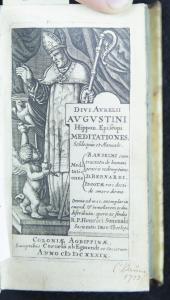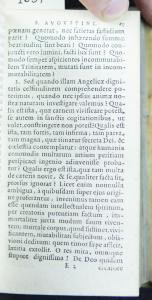

The works in this exhibit are all later versions or publications of titles, authors, or documents that are represented in the Rouse Medieval Manuscript collection. The exhibit content was created by students in a History of the Book seminar in Winter 2014 in the Information Studies Department at UCLA.
Exhibit Home
1. An exact collection of all remonstrances,...
3. Divi Avrelii Avgvstini Hippon. Episcopi...
4. Horae in laudem beatiss[ima] Virginis secu[n]dum....
5. Hore in laudem beatissime Virg[inis] Marie...
6. Les memoires, contenans le discours de plusieurs...
7. Modus Bene Viuendi (Modus Bene Vivendi)
8. Psalteriu[m] v[ir]ginis sanctissime [secundum]...
9. Q. Asco. Pediani In Ciceronis orationes...
10. Quaestiones super XII libros Metaphysicae...
11. Stimulus diuini amoris Sancti Bonauenturae
12. Varii sermoni de Santo Agostino...
13. Varii sermoni di Santo Agostino
Title Divi Avrelii Avgvstini Hippon. Episcopi Meditationes, Soliloquia et Manuale. Meditationes B. Anselmi cum tractatu De humani generis redemptione, D. Bernardi, Idiotae [pseud.] viri docti De amore divina. Omnia ad mss. exemplaria emend. & in meliorem ordin


Brief description Printed in Cologne, Germany in 1639, this book contains a collection of various soliloquies and mediations relating to the teachings of Saint Augustine of Hippo. Its diminutive size suggests it was portable and most likely intended for personal use by its owner. Aside from the block print picture on the title page, the book is unadorned. It is printed in simple Latin script, which suggests that its readers had some affiliation with the Catholic Church since the common classes by that time were using early forms of vernacular German instead of Latin. This particular copy of the Divi Avrelli was printed during a time of tremendous religious and social upheaval in Germany and across the European continent. The Thirty Years War (1618-1648) had entered its final decade, the end of which would usher in the rise of Protestantism, widespread adoption of the German language at the expense of Latin, both socially and in print, and finally the end of the Holy Roman Empire and the Catholic Church’s religious, social, and linguistic dominance in Europe.
Physical description There are four small holes down either side of the book spine front and back with cords or bands running through them. There is a sewn or threaded band along the top and bottom edges of the book along the spine. The book is hardbound, and the cover seems like it might be made from some sort of animal skin. Its diminutive nature suggests the book was portable and for personal use. Being printed in Latin suggests that its usage was restricted to those affiliated with or educated in the Catholic Church.
Content description The University situated in Cologne was one of the most prestigious in all of Europe and had a large influence on the burgeoning book trading market in the area. More so than in most of Germany, the University in Cologne was heavily loyal to the Catholic Church at the time, which is important for several reasons. One is that the Catholic Church was particularly interested in controlling how the Word of God was transmitted, and wanted to ensure that all text was communicated to the common people via the voice of clergy. At the time Divi Avrelli was printed in Cologne in 1639, access to these small prayer books was probably limited to clergy, missionaries and others who spoke Latin. The common people who spoke in early forms of German were becoming more interested in secular works, in addition to the traditional religious texts. Secondly this particular Divi Avrelli was printed during the midst of the Thirty Years War. This war, which lasted from 1618—1648, wreaked devastation across the continent and particularly Germany. As a result the Holy Roman Empire and the Catholic Church’s influence began to decline steadily. The University’s influence is important because they had the final say over what could be printed, and they were especially vigilant regarding the content of religious texts. Since Cologne as a whole and the University in particular were strongholds of the Catholic Church, the Church’s influence is reflected in the types of books being manufactured by printing shops in the city. This version of the Divi Avrelli was created right before a critical transitional moment when Protestantism and the German vernacular language began to take a more prominent role in German society, at the same time that the influence of traditional religious authority began to wane. The book is described as a collection of various meditations and soliloquies that draw directly or indirectly from the works of St. Augustine of Hippo. St. Augustine of Hippo was a philosopher whose work and life spanned the mid-4th to mid-5th century in what is now modern day Algeria. His philosophy had a strong influence upon the thinking of many of those who played fundamental roles in the development of modern Christian doctrine, including Thomas Aquinas, John Calvin, and Martin Luther.
Contributor: Mal Higgins
Contribution date: Winter 2014
Full title: Divi Avrelii Avgvstini Hippon. Episcopi Meditationes, Soliloquia et Manuale. Meditationes B. Anselmi cum tractatu De humani generis redemptione, D. Bernardi, Idiotae [pseud.] viri docti De amore divina. Omnia ad mss. exemplaria emend. & in meliorem ordin
Date 1639
Location Coloniae Agrippinae (Cologne, Germany)
Dimensions 3.5 by 5.5 inches
Technologies of production
Additional information Bibliographic Records I observed in the MARC record from the University of Toronto a note that says “the works attributed to St. Augustine and St. Bernard are supposititious,” which means “a substitute and not the real thing,” while in the UCLA MARC record in the same field it says “fictitious imprint.” I’m curious to know what these labels mean, whether they are the same or different, and what they indicate about the authenticity of the content of the work. Other Locations of Book (Academic, Public, Special Collections) BIBLIOTHEEK UNIVERSITEIT VAN AMSTERDAM (Netherlands) KONINKLIJKE BIBLIOTHEEK (Netherlands) TILBURG UNIVERSITEIT (Netherlands) BAYERRISCHE BIBLIOTHEK (Germany) HERZOGIN ANNA AMALIA BIBLIOTHEK (Germany) EVANGELISCHES PREDIGERSEMINAR (Germany) STAATSBIBLIOTHEK ZU BERLIN (Germany) BILIOTHÈQUE MUNICIPALE DE LYON (France) BIBLIOTHÈQUE DE GENÈVE (Switzerland) KINGS COLLEGE LONDON (England) UNIVERSITY OF TORONTO (Canada) GONZAGA UNIVERSITY (USA) UNIVERSITY OF ILLINOIS-URBANA CHAMPAIGN (USA) BRIGHAM YOUNG UNIVERSITY (USA) UNIVERSITY OF CALIFORNIA-BERKELEY (USA) HUNTINGTON LIBRARY (USA) MOUNT MARY UNIVERSITY (USA) (Source: WorldCat UCLA search) Other Editions/Online Access: There appear to be two versions of this book; one with 441 pages and one with 410. The list of libraries above accounts for both versions. As far as I’ve been able to determine there is no online copy of either of these versions, although other books by St. Augustine of Hippo have been digitized.
ConditionNotable darkening along the top edge of the front and back covers. Various small black dots, slightly larger brownish marks on the front and back covers. The pages are in remarkably good shape, with only occasional markings, and with what might be some very light water damage visible along the bottom of a few pages. The outer edges of the pages have darkened considerably to a greenish/dark grey color. The illustration on the title page appears to have been block printed. There is a small signature underneath the picture on the title page that is dated 1713.